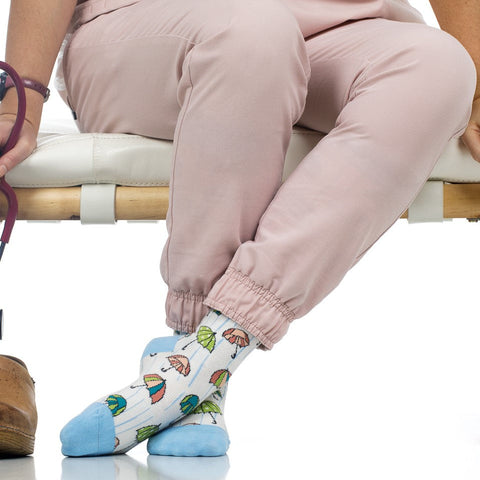A Physiotherapist Breaks Down How to Prepare for Your Next Nursing Shift
Nurses have one of the most necessary, demanding and stressful jobs in the world. Before I worked in private practice, I always marveled at the nurses’ ability to stay calm, develop relationships with patients and stay motivated in the hectic hospital environment. It’s not surprising that such a demanding vocation is associated with a number of health issues. Nursing staff report higher levels of stress, injuries and burnout than almost any other career. Thankfully, there are a few effective ways to help minimize the risk of developing these issues, as well as make a nurse’s workday more comfortable.
Nursing Compression Socks Can Minimize Lower Limb Soreness and Swelling
Lower limb complaints are the second most common musculoskeletal issue nurses experience due to their job. Unlike other roles where employees can sit down and rest at work, nurses are often on their feet for most of their day, with some nurses walking over 3 miles during a shift. This excessive standing and walking can lead to a 20 percent increase in strain on their lower-limb circulatory systems, leading to muscle soreness and bone tenderness. Add the increased swelling directly linked to long hours of standing, and it’s no surprise nurses experience high levels of lower limb discomfort at work.
There's many reasons why nurses should wear compression socks and thankfully, some modern brands have devised compression socks that are both functionally effective in minimizing lower limb soreness—and they’re stylish, too. Studies suggest the best compression socks for nurses with no comorbidities or risk factors for increased edema should have a compression level between 11 and 21 mmHg. This compression level can both treat and eliminate lower limb swelling without impeding the nurse’s ability to move normally throughout their workday.
As a nurse, when you hear the words “compression sock,” you probably think of the bright white, post-operative stockings you put on patients. Thankfully, great brands specializing in compression socks for nurses have created options with fun prints and designs, making them more appealing to wear at work.

Integrate Three Gentle Movements into Your Healthy Morning Routine
Nurses are at high risk of musculoskeletal injuries due to the nature of their work. Much of their time is spent walking, bending, stretching, standing and reaching, leading to a high number of back pain cases reported by nurses each year. In fact, musculoskeletal disorders were reported at an incidence rate of 46.0 cases per 10,000 full-time workers, significantly greater than the rate for all other occupations (29.4 cases per 10,000 workers). Most of these musculoskeletal disorders are related to the back, particularly the lumbar spine, or lower back.
To combat the risk of back pain at work though, nurses can introduce a short injury prevention routine into their pre-shift preparation. Here’s what I recommend:
1. Gentle Pelvic Tilts
- While you’re eating your pre-shift meal, sit up tall in a chair with both feet planted.
- Place your hands on the bony sections of your pelvis (like hands on hips).
- Gently roll your pelvis forward to create a “sway back” posture.
- Gently roll your pelvis backward to create a “tucked” posture.
Continue for 10 repetitions. Don’t push or pull, and breathe slowly with each movement. This exercise mobilizes the lower back and pelvis, helping to gently restore movement to the joints that are most at risk during your shift.

2. Dynamic Calf Stretches on a Step
- Stand on the edge of a step holding onto a railing.
- Gently lower your heels down below the step so you feel a stretch in your calf.
- Slowly rise up onto the ball of your foot so you’re on your tiptoes.
- Gently lower back down so your heel is below the step.
Repeat this exercise for two sets of five. Move slowly, and don’t push past where it feels comfortable. This exercise helps to stretch your calf muscles, largely the gastrocnemius, in a dynamic way to help prevent injury to your ankles and lower limbs during your shift.
3. Spinal Rotations
- Sit up tall on a chair with both feet planted.
- Holding onto the seat of the chair, gently pull your body around until your shoulders are rotated as far as feels comfortable.
- Don’t rotate your neck; just look straight ahead. Aim to keep the rotation limited to your middle back (thoracic spine).
- Breathe in, and release the twist to halfway.
- Breathe out, and gently twist again.
Go gently with this exercise, and repeat five times on each side. This can also be done while standing, with the arms out at shoulder height.
Replace Your Pillow
I see so many nurses for treatments in-clinic who complain of waking up with a headache almost every day. One of the most common causes of this is a poorly fitted pillow. Nurses need their sleep, whether they’re sleeping during the day before their night shift, resting in the nurse’s room or sleeping at home between shifts. If you’re sick of waking up with headaches before your shift, it’s time to look at your pillow.
I recommend a latex pillow that won’t lose its shape. Most women can usually fit a “standard size” latex pillow, but it’s best if you can try out the size at a bedding store or physiotherapy clinic. You will feel if it’s too high or low. If you’re not sure which pillow to buy, look on your country’s Physiotherapy Association website. Most associations will recommend a certain brand, which can help steer you in the right direction.

Breathing and Meditation Are Life-Changing Good Habits
Introducing just 10 minutes of concentrated breathing and meditation into your daily routine has been proven to effectively minimize stress and burnout in health professionals.
One study recruited health professionals, including 12 nurses, to examine the effects of a 12-week meditation and mindfulness course. The results were astounding.
After 12 weeks, the meditators had statistically significant improvement in all measures of burnout and almost all values of emotional wellness (EWA). The 12 control participants observed no change in their burnout or emotional wellness scores.
If you’re new to meditation, I recommend using an app. Great meditation apps take you through a guided meditation and help you stay focused on your breathing. This helps you forget about your busy day, slow down, and refocus your mind to help you experience less perceived stress at work.
As a physiotherapist, I utilize a wide range of strategies to help busy people like nurses feel more comfortable at work. These range from mobility exercises to what socks you wear — and even meditation. If you’re sick of feeling stressed and sore at work, try the solutions above. Even one small change can make a significant difference.
Caitlin Reid is a physiotherapist with a special interest in musculoskeletal injuries and holistic well-being, blending the realms of evidence-based medicine with inspiring holistic health.
Note: Always seek the advice of your physiotherapist, doctor or other qualified health provider with any questions you may have regarding any medical condition.

References
http://ajcc.aacnjournals.org/content/24/5/412.short
https://journals.sagepub.com/doi/full/10.1177/2165079917727011
https://vimvigr.com/pages/compression-socks-for-work
https://www.ncbi.nlm.nih.gov/pmc/articles/PMC4591921/
https://onlinelibrary.wiley.com/doi/abs/10.1111/j.1524-4725.2004.30204.x
https://vimvigr.com/collections/popular-styles-for-work
https://www.dunlopillo-bedding.com.au/why-choose-dunlopillo
https://www.tandfonline.com/doi/full/10.1080/20009666.2016.1270806


















Leave a comment